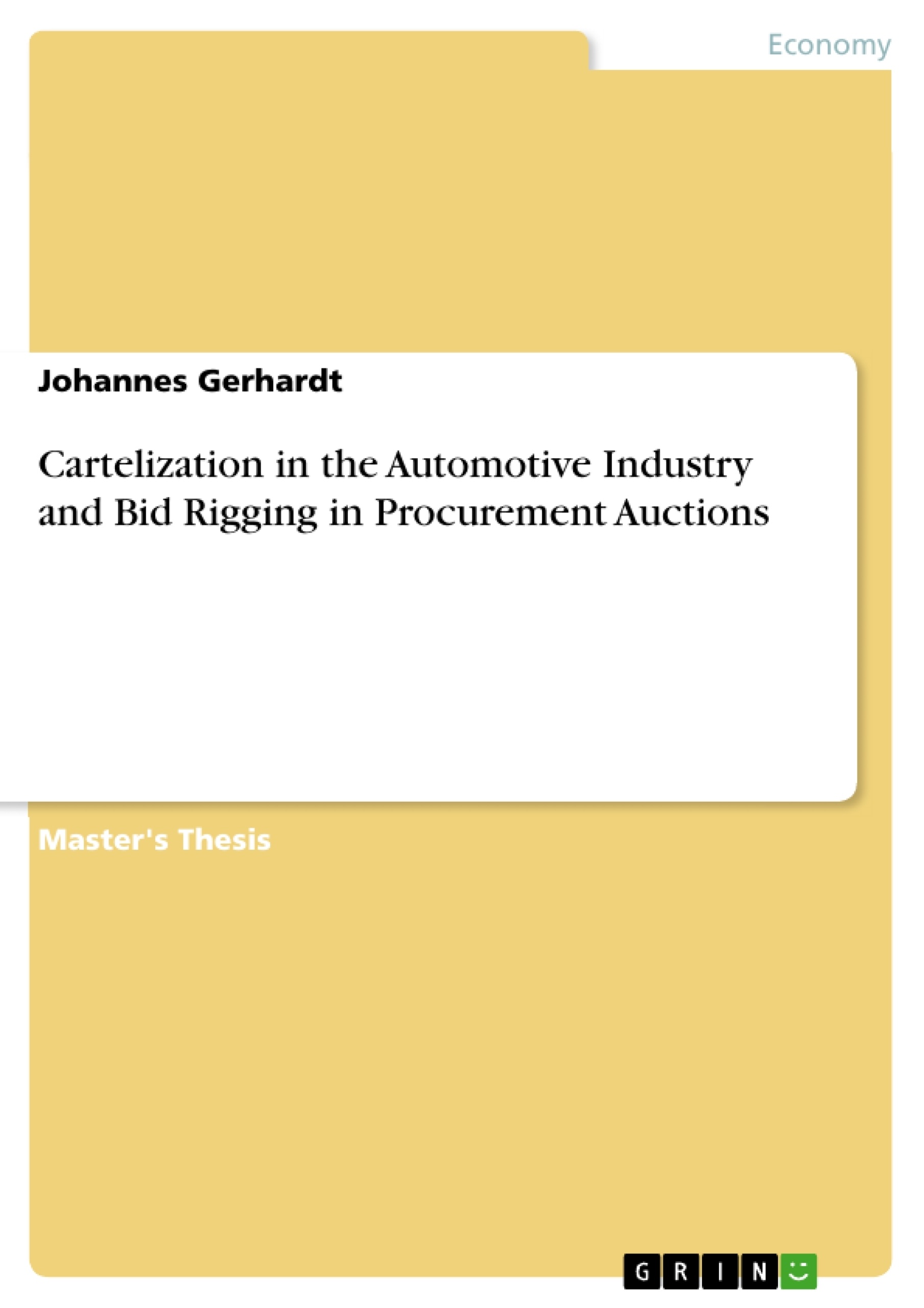Due to the high importance of the automotive industry for the EU and the growing number of discovered automotive supplier cartels in this economic area, the purpose of the master thesis at hand is to analyze and display why cartelization – especially among automotive suppliers in the EU – is observed so frequently. Particularly, it investigates factors that facilitate collusion of car part manufacturers.
Furthermore, it focuses on cartelization in procurement auctions as the touch point of automotive manufacturers and suppliers where collusive activities are executed. Hence, it examines the current state of theoretical research on collusive mechanism in auctions and provides implications for further research. Finally, it analyzes approaches to prevent collusion and assesses whether such measures are applicable to the automotive industry.
The thesis is structured as follows: After this introduction, chapter two defines the scope of the industry for this paper and provides a broad overview of its different sectors and significant players. In addition, due to their overall importance for the following analysis, procurement and bidding processes in the automotive industry are exhibited upfront. To emphasize the industry’s importance for the EU, an outline of the state of this industry sector in the EEA is given.
Building on that, chapter three presents a general introduction to cartelization in the automotive industry, followed by a presentation of three representative recent cartel cases in the EU: Car Glass, Automotive Bearings and Parking Heaters. This sets ground for a detailed analysis of the prevailing environment in the automotive industry. First, the analysis examines the manufacturer side including degrees of concentration, dominant strategies and effects of the automotive manufacturers’ market power. This is followed by an analysis of the supplier side regarding concentration and barriers to entry. Contingent on the analysis, factors that facilitate collusion in the automotive industry are summarized
To introduce collusion in auctions, chapter four starts with an outline of the theoretical foundation of auction theory. Based on this, auction formats that foster collusion and stability of cartels are discussed. Furthermore, the most relevant incentive compatible mechanisms are introduced distinguishing between one-shot and repeated auction games.
Table of Contents
- Introduction
- General Insights in the Automotive Industry
- Definition and Delimitation of the Automotive Industry and its Sectors
- Procurement and Bidding Processes in the Automotive Industry
- The Automotive Industry in the European Union and Germany
- Cartelization in the Automotive Industry
- Car Part Cartels in the European Union
- Car Glass EC Case 39125
- Automotive Bearings – EC Case 39922
- Parking Heaters - EC Case 40055
- Industry Analysis
- Buyer Power and Strategies of Automotive Manufacturers
- The Supplier Side of the Automotive Industry
- Factors that Facilitate Collusion of Automotive Suppliers
- Collusion in Auctions
- Theoretical Foundation of Auction Theory
- Auction Formats that Foster Collusion and Stability of Bidding Rings
- Collusion in One-Shot Auctions
- Collusion in Repeated Auctions
- Implications for the Automotive Industry
- Preventing Collusion in Auctions
- Conclusion
Objectives and Key Themes
This work explores the phenomenon of cartelization in the automotive industry, specifically focusing on bid rigging in procurement auctions. It analyzes the factors that contribute to collusion among automotive suppliers and examines the impact of such practices on the industry's competitiveness and consumer welfare.- The prevalence and impact of cartelization in the automotive industry
- The role of procurement auctions in facilitating collusion
- The factors that contribute to collusion among automotive suppliers
- The theoretical framework of auction theory and its implications for collusion
- Strategies for preventing collusion in procurement auctions
Chapter Summaries
- Introduction: This chapter provides a general overview of the increasing prevalence of cartelization in the automotive industry, particularly among suppliers. It highlights the significance of the automotive industry for the European Union and the detrimental effects of collusion on competition and consumer welfare.
- General Insights in the Automotive Industry: This chapter delves into the definition and scope of the automotive industry, encompassing various sectors. It also examines the procurement and bidding processes prevalent within this industry, particularly emphasizing the role of auctions.
- Cartelization in the Automotive Industry: This chapter focuses on the specific instances of car part cartels that have emerged in the European Union. It presents case studies of car glass, automotive bearings, and parking heaters, providing insights into the nature and consequences of these cartels.
- Collusion in Auctions: This chapter explores the theoretical foundation of auction theory and its relevance to collusion. It examines different auction formats that can foster collusion and analyzes the mechanisms by which bidding rings can be established and maintained.
Keywords
This study focuses on cartelization, bid rigging, procurement auctions, collusion, antitrust investigations, automotive industry, suppliers, manufacturers, competition law, European Union, and auction theory.- Citar trabajo
- Johannes Gerhardt (Autor), 2016, Cartelization in the Automotive Industry and Bid Rigging in Procurement Auctions, Múnich, GRIN Verlag, https://www.grin.com/document/349793



